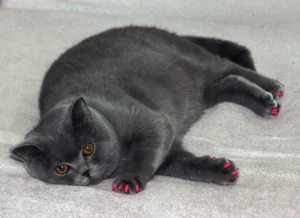Cats are beloved companions, but they can also face health challenges like diabetes. Understanding why cats develop diabetes can help pet owners provide the best care for their furry friends.
Diabetes in cats is a complex condition that results from various factors. Let’s explore the reasons behind this common health issue and how pet owners can support their diabetic feline companions.
Genetics and Breed Predisposition
When it comes to diabetes in cats, genetics and breed predisposition can significantly impact their likelihood of developing the condition. Certain breeds, such as Burmese and Siamese, are more prone to diabetes due to genetic factors. If your feline friend belongs to one of these breeds or has a family history of diabetes, it’s essential to be extra vigilant about their health.
Additionally, just like in humans, genetics can play a role in how a cat’s body processes glucose and insulin. This can lead to insulin resistance or insufficient insulin production, both of which are key factors in the development of diabetes.
To help mitigate the impact of genetics on your cat’s health, it’s crucial to monitor their weight, diet, and overall well-being closely. Regular vet check-ups can also catch any early signs of diabetes, allowing for prompt treatment and management.
Unique Insight: Genetics can be a significant factor in diabetes risk for cats, but environmental factors also play a crucial role. By providing a healthy lifestyle for your cat, you can help offset genetic predispositions and reduce their likelihood of developing diabetes.
Obesity and Diet
Obesity and diet are two interconnected factors that can greatly influence a cat’s risk of developing diabetes. Cats that are overweight or obese are more likely to develop insulin resistance, which can lead to diabetes over time. This makes maintaining a healthy weight through proper diet and exercise essential in preventing this condition.
A diet rich in carbohydrates and unhealthy fats can also contribute to diabetes in cats. High-carb diets can lead to spikes in blood sugar levels, putting stress on the pancreas and potentially leading to insulin resistance. Opting for a high-protein, low-carb diet can help regulate blood sugar levels and reduce the risk of diabetes.
By feeding your cat a balanced diet tailored to their specific nutritional needs and encouraging regular physical activity, you can help them stay healthy and reduce the chances of developing diabetes.
For more information on feline nutrition and weight management, check out this resource from the American Association of Feline Practitioners: Feline Nutrition
Age and Hormonal Factors
As cats age, they become more prone to developing diabetes. Just like in humans, aging can affect the way a cat’s body processes glucose, leading to insulin resistance and elevated blood sugar levels. Additionally, hormonal factors can play a significant role in the development of diabetes in senior felines. As cats get older, changes in hormone levels can impact their metabolism and insulin production, increasing the risk of diabetes. Keep an eye on your older feline friends and consult your vet if you notice any concerning symptoms.
Lack of Exercise
Regular exercise is crucial in preventing diabetes in cats. A sedentary lifestyle can contribute to weight gain, which is a significant risk factor for diabetes. By keeping your cat active and engaged, you can help maintain a healthy weight and reduce the chances of developing diabetes. Interactive toys, laser pointers, and even simple play sessions can all help keep your furry friend moving. So, make sure your cat gets plenty of opportunities to stretch their legs and stay fit.
Additional Unique Insight:
Healthy Diet: Providing your cat with a balanced and nutritious diet can also play a key role in preventing diabetes. Avoid overfeeding and opt for high-quality cat food that supports their overall health. Consult with your vet to determine the best diet for your feline companion. By combining a healthy diet with regular exercise, you can help reduce the risk of diabetes and keep your cat happy and healthy.
Stress and Environmental Factors
Cats, like humans, can be affected by stress and their environment. High-stress levels and exposure to certain environmental factors can impact a cat’s overall health, potentially increasing the risk of developing diabetes. Stress can lead to a variety of health issues, including impaired glucose metabolism, which can contribute to the development of diabetes in cats. Similarly, environmental factors such as an unhealthy diet, lack of physical activity, and obesity can also play a role in diabetes development. Ensuring a stress-free environment, providing mental stimulation, and maintaining a healthy lifestyle can help reduce the risk of diabetes in cats.
Symptoms and Early Detection
Detecting diabetes in cats early is crucial for successful treatment and management. It is important to be aware of common symptoms such as increased thirst, frequent urination, weight loss, lethargy, and increased appetite. If you notice any of these signs in your cat, it is essential to seek veterinary care promptly. Early detection can help prevent complications associated with diabetes and allow for appropriate treatment, such as dietary changes, medication, and insulin therapy. Regular veterinary check-ups and monitoring your cat’s behavior can aid in the early detection of diabetes, improving your cat’s quality of life.
- Regular Check-ups: Schedule routine veterinary visits to monitor your cat’s health and catch any potential issues early.
- Monitoring Behavior: Pay attention to changes in your cat’s behavior, including eating habits, water intake, and energy levels to detect any abnormal patterns that may indicate diabetes.
- Healthy Diet: Provide your cat with a balanced diet to maintain a healthy weight and reduce the risk of diabetes development.
- Exercise: Encourage physical activity to keep your cat at a healthy weight and improve overall health.
- Consult with a Veterinarian: If you suspect diabetes or notice any concerning symptoms, consult with your veterinarian for proper diagnosis and treatment.
Remember, early detection and proactive management are key in addressing diabetes in cats. Stay vigilant and prioritize your cat’s health for a happy and fulfilling life.
Treatment Options and Management
Diabetes in cats can be managed through a combination of medication, diet, and monitoring. Insulin injections are often necessary to regulate blood sugar levels, and your veterinarian will determine the right dosage for your cat. It’s crucial to follow the prescribed insulin schedule diligently.
In addition to medication, diet plays a significant role in managing feline diabetes. High-protein, low-carbohydrate diets are typically recommended for diabetic cats to help control blood sugar levels. Consult with your vet to find the best diet plan for your furry friend.
Regular monitoring of your cat’s blood sugar levels is essential for effective management. Regular veterinary check-ups are crucial to ensure your cat’s diabetes is under control. By working closely with your veterinarian, you can develop an effective treatment plan tailored to your cat’s specific needs.
Remember, consistency is key when managing feline diabetes. Stick to a routine for feeding, medication, and monitoring to help your cat live a happy and healthy life despite their condition.
Additional Insight: Regular exercise can also be beneficial for diabetic cats, so try to engage your feline friend in playtime to help maintain a healthy weight and improve overall well-being.
Unique Challenges for Diabetic Cats
Diabetic cats may face unique challenges related to their condition that require special attention from pet owners. Maintaining a stable routine is essential for diabetic cats to ensure they receive their medication and meals at the same time each day. Any changes in routine can affect their blood sugar levels.
Monitoring for signs of hypoglycemia (low blood sugar) is crucial for diabetic cats. Symptoms may include weakness, tremors, and disorientation. If you notice any signs, it’s important to act quickly by providing a small amount of food to raise their blood sugar levels.
Handling stress can also be a challenge for diabetic cats, as stress can impact their blood sugar levels. Create a calm and comfortable environment for your cat to help reduce stress and promote overall well-being.
Regular veterinary check-ups are essential to monitor your cat’s condition and make any necessary adjustments to their treatment plan. By staying proactive and attentive, you can help your diabetic cat live a happy and healthy life.
Remember, patience and dedication are key when caring for a diabetic cat. With proper management and attention to their unique challenges, you can help your feline friend thrive despite their condition.
Why Do Cats Develop Diabetes?
Cats can develop diabetes when their bodies are unable to regulate glucose properly. This can happen for various reasons, but the most common culprits are obesity, genetic predisposition, and a sedentary lifestyle. When cats consume more calories than they can burn off, their bodies struggle to maintain proper blood sugar levels, leading to insulin resistance and eventually diabetes.
One key factor in diabetes development in cats is obesity. Just like in humans, excess weight can put a strain on the body’s ability to process glucose effectively. This is why maintaining a healthy weight through a balanced diet and regular exercise is crucial in preventing diabetes in cats.
Furthermore, certain breeds are more prone to developing diabetes due to their genetic makeup. Breeds like Burmese, Siamese, and Russian Blue cats are at a higher risk, so extra care and monitoring are needed for these feline friends.
Ultimately, ensuring your cat has a healthy lifestyle with a proper diet, regular exercise, and veterinary check-ups can significantly reduce the risk of diabetes development.
Supporting Your Diabetic Cat
Supporting a diabetic cat involves a combination of proper diet, monitoring blood glucose levels, and regular veterinary care. Diet is crucial, as it directly impacts blood sugar levels. Feeding your cat high-quality, low-carbohydrate food can help regulate blood glucose levels more effectively. Additionally, regular monitoring of blood glucose levels at home using a special meter can provide valuable insights into your cat’s condition.
It’s also essential to maintain a consistent routine for feeding, insulin administration (if prescribed), and exercise. This helps create a stable environment for your cat, which is especially important for diabetic cats.
Lastly, frequent veterinary check-ups are key to managing your diabetic cat’s condition. Your vet can assess your cat’s overall health, adjust treatment plans as needed, and provide guidance on caring for a diabetic cat effectively.
Fun Facts About Cats and Diabetes
- Cats have a unique metabolism, making them more prone to diabetes compared to other animals.
- Unlike dogs, cats rely more on protein for energy, which can impact their insulin sensitivity.
- Male cats are more likely to develop diabetes than females.
- The average age for diabetes diagnosis in cats is around 10 years old.
- Cats can go into remission from diabetes with proper treatment and management.
For more information on caring for a diabetic cat, check out this resource.
Alex, a passionate animal lover, has experience in training and understanding animal behavior. As a proud pet parent to two dogs and three cats, he founded AnimalReport.net to share insights from animal experts and expand his knowledge of the animal kingdom.




